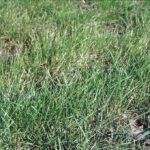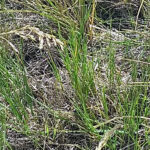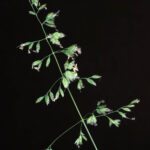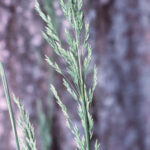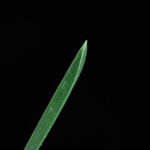Kentucky Bluegrass
Poa pratensis
General Description
Kentucky bluegrass is a widely adapted, long-lived, persistent, low-growing perennial grass. Its roots are shallow, fibrous and concentrated near the soil surface. It eventually forms a very firm sod from the spread of slender rhizomes. Characteristics of the rhizomes vary with variety. There are numerous other bluegrass species found within western Canada.
Kentucky bluegrass produces fine stems up to 75 cm (30 in) long. The leaves are basal, soft, and smooth. At the bud stage, leaf blades are folded, flat, or V-shaped, and have a boat-shaped tip. Leaf blades when flattened out are 2 to 5 mm (1/16 to 1/5 in) wide. Seed heads form on bluish-coloured triangular-shaped panicles about 5 to 10 cm (2 to 4 in) long.
Type
Tame grass & native grass.
Origin
Kentucky bluegrass was introduced to North America from Europe, where it was known as “smooth meadow grass”. It became known as the “white man’s foot grass” to the First Nations, because it followed settlement as it moved west. Many people consider it a native species in some soil zones.
Longevity
At least 20 years.
Use
Pasture, reclamation.
Optimal Time of Use
Spring, fall. Kentucky bluegrass can be grazed continually or rotationally. Lower production in summer does not lend to optimal use in summer. Snow cover will restrict winter grazing although quality can hold.
Recovery After Use
Requires a minimum of 30 days of recovery after use. Highly resistant to grazing. Under moist conditions, recovery and regrowth after grazing are quick. Grazing Kentucky bluegrass to a height of 5 to 15 cm (2 to 6 in) helps maintain its forage quality.
Palatability/Nutritional Value
In the vegetative stage, Kentucky bluegrass is noted to have 10 to 12% protein and a TDN of about 67%. While dry in the summer palatability is lessened, but fall usage can see good palatability and nutritional quality.
Annual Precipitation min/max (mm)
350mm / 1100mm
Drought Tolerance
Moderate tolerance. Kentucky bluegrass goes dormant with no growth during periods of dryness or drought.
Flooding Tolerance
Withstands up to 2 to 5 weeks of spring flooding and waterlogged soils. Kentucky bluegrass is highly moisture dependant.
Winter Hardiness
Excellent hardiness.
Soil Texture Preference
Prefers well-drained, fertile, moist soils. Because of its need for moisture, Kentucky bluegrass often grows better on clay, silty, or peat soils, but can adapt to moist sandy soils.
Erosion Control
Moderate ability to control erosion. Forms a rhizomatous mat once established.
Salinity Tolerance
Not tolerant.
Acidity Tolerance
Moderate tolerance.
Alkalinity Tolerance
Low tolerance.
Seeds per kg
4,800,000 seeds/kg (2,177,000 seeds/lb)
Suggested Mixtures
Can be compatible with legumes such as birdsfoot trefoil, alsike clover, and white clover.
Ease of Establishment
Kentucky bluegrass easily germinates and can begin to establish, but requires good moisture to help the fine seedlings root. Rhizomes begin growing the year after establishment.
Competitiveness
Highly competitive. It is considered a minor upland invasive in the E-Flora Invasive, Noxious and Problem Plants of British Columbia 2012 Update. Its competitiveness means that it can invade pastures and native range, especially when closely grazed. It can persist in the lower part of the plant community and increases as taller species decline.
Management Considerations
Select variety based on performance traits that are desired, such as yield. Kentucky bluegrass has a high demand for moisture, nitrogen, and phosphorus. Most commonly used for turf grass in Canada. Once established, it can be difficult to remove from a stand, however that may be area dependant.
British Columbia Rangeland Seeding Manual, Saskatchewan Dryland Forage Species Adaptation Tool, USDA Plants Database, Manitoba Forage Adaptation and Comparison Guide, Alberta Forage Manual
Kentucky bluegrass is adapted to the Sub-Boreal Spruce, Interior Cedar-Hemlock and Sub-Boreal Pine-Spruce zones. In the southern part of the region it is adapted to wetter parts of the Interior Douglas-fir zone, and to irrigated and subirrigated areas in the Bunchgrass zone and drier parts of the Interior Douglas-fir zone. It will commonly occupy moist depressions in heavily grazed pastures in the drier zones.
Kentucky bluegrass is adapted to the wetter parts of the Interior Douglas-fir zone and the Interior Cedar-Hemlock zone, and to irrigated and subirrigated areas in the Bunchgrass, Ponderosa Pine zones and drier parts of the Interior Douglas-fir zone. It will commonly occupy moist depressions in heavily grazed pastures in the drier zones of the interior.
